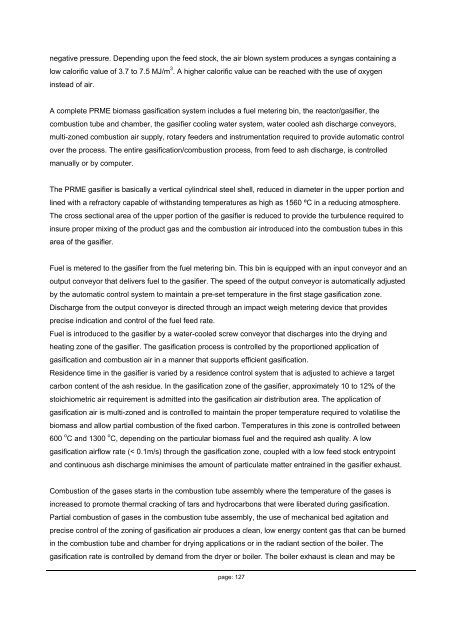Adding gas from biomass to the gas grid - SGC
Adding gas from biomass to the gas grid - SGC
Adding gas from biomass to the gas grid - SGC
- No tags were found...
You also want an ePaper? Increase the reach of your titles
YUMPU automatically turns print PDFs into web optimized ePapers that Google loves.
negative pressure. Depending upon <strong>the</strong> feed s<strong>to</strong>ck, <strong>the</strong> air blown system produces a syn<strong>gas</strong> containing alow calorific value of 3.7 <strong>to</strong> 7.5 MJ/m 3 . A higher calorific value can be reached with <strong>the</strong> use of oxygeninstead of air.A complete PRME <strong>biomass</strong> <strong>gas</strong>ification system includes a fuel metering bin, <strong>the</strong> reac<strong>to</strong>r/<strong>gas</strong>ifier, <strong>the</strong>combustion tube and chamber, <strong>the</strong> <strong>gas</strong>ifier cooling water system, water cooled ash discharge conveyors,multi-zoned combustion air supply, rotary feeders and instrumentation required <strong>to</strong> provide au<strong>to</strong>matic controlover <strong>the</strong> process. The entire <strong>gas</strong>ification/combustion process, <strong>from</strong> feed <strong>to</strong> ash discharge, is controlledmanually or by computer.The PRME <strong>gas</strong>ifier is basically a vertical cylindrical steel shell, reduced in diameter in <strong>the</strong> upper portion andlined with a refrac<strong>to</strong>ry capable of withstanding temperatures as high as 1560 ºC in a reducing atmosphere.The cross sectional area of <strong>the</strong> upper portion of <strong>the</strong> <strong>gas</strong>ifier is reduced <strong>to</strong> provide <strong>the</strong> turbulence required <strong>to</strong>insure proper mixing of <strong>the</strong> product <strong>gas</strong> and <strong>the</strong> combustion air introduced in<strong>to</strong> <strong>the</strong> combustion tubes in thisarea of <strong>the</strong> <strong>gas</strong>ifier.Fuel is metered <strong>to</strong> <strong>the</strong> <strong>gas</strong>ifier <strong>from</strong> <strong>the</strong> fuel metering bin. This bin is equipped with an input conveyor and anoutput conveyor that delivers fuel <strong>to</strong> <strong>the</strong> <strong>gas</strong>ifier. The speed of <strong>the</strong> output conveyor is au<strong>to</strong>matically adjustedby <strong>the</strong> au<strong>to</strong>matic control system <strong>to</strong> maintain a pre-set temperature in <strong>the</strong> first stage <strong>gas</strong>ification zone.Discharge <strong>from</strong> <strong>the</strong> output conveyor is directed through an impact weigh metering device that providesprecise indication and control of <strong>the</strong> fuel feed rate.Fuel is introduced <strong>to</strong> <strong>the</strong> <strong>gas</strong>ifier by a water-cooled screw conveyor that discharges in<strong>to</strong> <strong>the</strong> drying andheating zone of <strong>the</strong> <strong>gas</strong>ifier. The <strong>gas</strong>ification process is controlled by <strong>the</strong> proportioned application of<strong>gas</strong>ification and combustion air in a manner that supports efficient <strong>gas</strong>ification.Residence time in <strong>the</strong> <strong>gas</strong>ifier is varied by a residence control system that is adjusted <strong>to</strong> achieve a targetcarbon content of <strong>the</strong> ash residue. In <strong>the</strong> <strong>gas</strong>ification zone of <strong>the</strong> <strong>gas</strong>ifier, approximately 10 <strong>to</strong> 12% of <strong>the</strong>s<strong>to</strong>ichiometric air requirement is admitted in<strong>to</strong> <strong>the</strong> <strong>gas</strong>ification air distribution area. The application of<strong>gas</strong>ification air is multi-zoned and is controlled <strong>to</strong> maintain <strong>the</strong> proper temperature required <strong>to</strong> volatilise <strong>the</strong><strong>biomass</strong> and allow partial combustion of <strong>the</strong> fixed carbon. Temperatures in this zone is controlled between600 o C and 1300 o C, depending on <strong>the</strong> particular <strong>biomass</strong> fuel and <strong>the</strong> required ash quality. A low<strong>gas</strong>ification airflow rate (< 0.1m/s) through <strong>the</strong> <strong>gas</strong>ification zone, coupled with a low feed s<strong>to</strong>ck entrypointand continuous ash discharge minimises <strong>the</strong> amount of particulate matter entrained in <strong>the</strong> <strong>gas</strong>ifier exhaust.Combustion of <strong>the</strong> <strong>gas</strong>es starts in <strong>the</strong> combustion tube assembly where <strong>the</strong> temperature of <strong>the</strong> <strong>gas</strong>es isincreased <strong>to</strong> promote <strong>the</strong>rmal cracking of tars and hydrocarbons that were liberated during <strong>gas</strong>ification.Partial combustion of <strong>gas</strong>es in <strong>the</strong> combustion tube assembly, <strong>the</strong> use of mechanical bed agitation andprecise control of <strong>the</strong> zoning of <strong>gas</strong>ification air produces a clean, low energy content <strong>gas</strong> that can be burnedin <strong>the</strong> combustion tube and chamber for drying applications or in <strong>the</strong> radiant section of <strong>the</strong> boiler. The<strong>gas</strong>ification rate is controlled by demand <strong>from</strong> <strong>the</strong> dryer or boiler. The boiler exhaust is clean and may bepage: 127
















